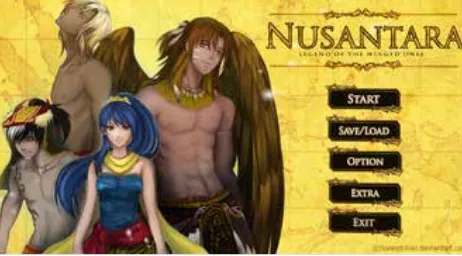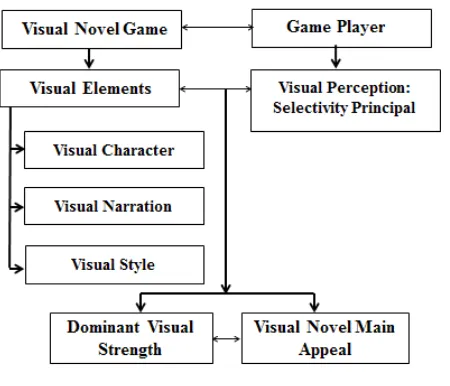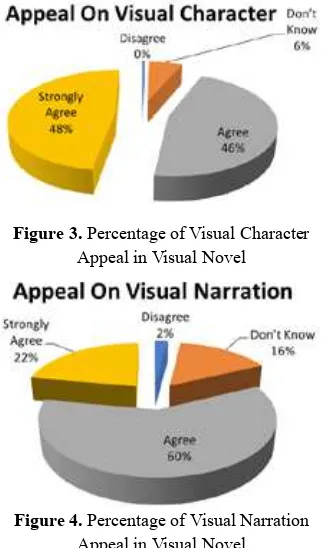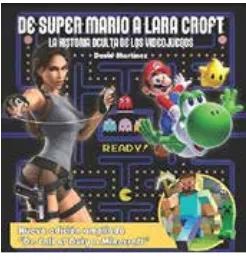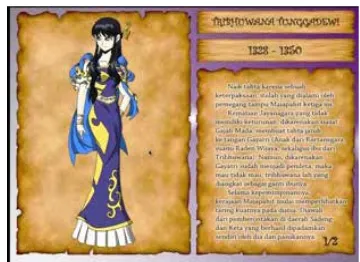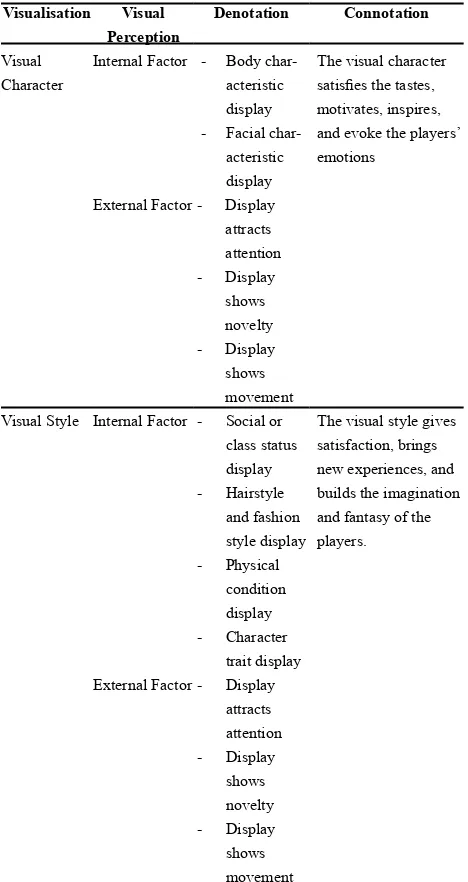The Visual Elements Strength in Visual Novel Game Development
as the Main Appeal
Dendi Pratama1, Winny Gunarti Widya Wardani2, dan Taufiq Akbar3 1,2,3 Visual Communication Design, Faculty of Language and Art, Universitas Indraprasta PGRI
Jl. Nangka No. 58, Tanjung Barat, Jakarta Selatan 12530, Indonesia
Currently, visual novel games can be downloaded easily via android-based smartphones or played on the computer. The ease of access is certainly needed to be supported by visual appeal, so that users are interest-ed to play it continuously. In visual novel games, the visual elements that build the game consist of visual characters, visual narration, and visual styles. This study analyzes these three visual elements to know which elements have dominant visual strength and become the main appeal. The discussion of this study using mix method, that is qualitative and quantitative with visual perception and semiotic approach. Qualitatively, the analysis of the three elements of the game’s appeal shows the existence of visual signs that can build percep-tion such as visual character, visual narrapercep-tion, and visual style. While quantitatively, the analysis shows that visual styles and visual characters have a more dominant visual strength as the main appeal. The results of this study are expected to be a reference for local game developers. The three visual elements that appeal to the visual novel games must match the needs of the market. Visual novel games that can attract attention and meet the needs of its users potentially become more competitive in the global market.
Keywords : Visual elements strength, visual novel, game, main appeal
Kekuatan Unsur Visual Dalam Penciptaan Game Visual Novel
Sebagai Daya Tarik Utama
Saat ini, permainan visual novel dapat diunduh dengan mudah melalui telepon pintar berbasis android atau dimainkan lewat komputer. Kemudahan akses tersebut tentunya perlu didukung oleh daya tarik visual, agar para pengguna tertarik untuk memainkannya secara terus-menerus. Dalam game visual novel, unsur-unsur visual yang membangun permainan di dalamnya terdiri dari karakter visual, narasi visual, dan gaya visual. Studi ini menganalisis ketiga unsur visual tersebut untuk mengetahui unsur-unsur yang memiliki kekuatan visual dominan dan menjadi daya tarik utama. Pembahasan studi ini menggunakan metode kombinasi, yaitu kualitatif dan kuantitatif dengan pendekatan persepsi visual dan semiotika. Secara kualitatif, analisis terhadap ketiga unsur daya tarik game tersebut menunjukkan adanya tanda-tanda visual yang dapat membangun persep-si, seperti karakter visual, narasi visual, dan gaya visual. Sedangkan secara kuantitatif, analisis menunjukkan bahwa gaya visual dan karakter visual memiliki kekuatan visual yang lebih dominan sebagai daya tarik utama. Hasil studi ini diharapkan dapat menjadi referensi bagi para pengembang game lokal, sehingga ketiga unsur visual yang menjadi kekuatan daya tarik game visual novel dapat disesuaikan dengan kebutuhan pasar. Game visual novel yang dapat menarik perhatian dan memenuhi kebutuhan para penggunanya berpotensi menjadi lebih kompetitif di pasar global.
Kata kunci : Kekuatan unsur visual, visual novel, game, daya tarik
INTRODUCTION
The development of digital games in Indonesia is now ac-celerating and opening up competitive opportunities for local game developers in global market. The potential of this creative industry is also supported by the advances in mobile telecommunication technology or smart phones. Quoted from Samuel Henry of the International Game Development Association (IGDA), data for the period of 2012 to 2013, shows the increment of local gaming studios amount, both small, medium, and large, up to 100 percent, (Pratama, et al., 2017: KOM - 45).
Based on the observations, game production made var-ies, ranging from the type to its genre. But generally the types of games offered now allow to be played through a computer, using a console, or on mobile. While the genre, ranging between the genre of action, fighting, role playing game (RPG), sports, strategy, simulation, and adventure. Among all the genres usually the players are presented a narrative that arouse challenges and curiosity.
Visual novels or so called sound novels is included in games that combine adventure genres with drama and romance, and are presented through a series of framed stories in addition to mystery. Visual novels are general-ly played on the computer, but can also be downloaded via android based phones. Through the Visual Novel (VN) Project Indonesia community site, visual novelist’s fan can download and select narrative themes from local game de-velopers, from romance, fantasy, life romance to historical action. Generally visual novels by local developers are still influenced by the Japanese anime style, where the origin of the game genre is produced. Of many stories that are raised, visual novel games with the theme of Indonesian history are still very limited. Among those that are quite popular are the visual novel titled Nusantara: Legend of The Winged Ones, the work of SweetChiel developers, which can be played with Windows, macOS, and Linux. In its official website at sweetchiel.itch.io, the visual novel is claimed to have been downloaded up to 10,000 by its users. This visual novel takes the background of historical narratives of the kingdoms that ever existed in Nusantara by displaying the characters according to history with dif-ferent visual styles, also featuring fictitious fantasy char-acters.
Visual novel example above is interesting to be a refer-ence, because a production of visual novel local games that are able to attract the attention of its users is certainly not apart from the ease of access and visual appeal. The power of visual appeal can encourage game enthusiasts to access and play on an on going basis, such as changing character expressions, storylines that contain mysteries, plus sound effects. The power of visual appeal is also built through its elements, and in the visual novel game, there are three main elements that build the game, namely visual
Figure 1. Visual novel Nusantara: Legend of The Winged Ones Source:
(https://sweetchiel.itch.io/new-nusantara-legend-of-the-winged-ones, accessed 18th September 2018) character, visual narration, and visual style.
As a product of visual communications design, visual nov-els integrate graphic design skills through a choice of vi-sual styles, vivi-sual character designs, and vivi-sual narrative designs through interactive communicative story construc-tion. In this case, the visual elements of design are interre-lated, such as lines, shapes, plane, colour, texture, space, and motion, to produce beauty and appeal in its visual-ization. The unity of the element must still consider the elements of harmony, balance, and visual focus that going to be the vocal point (Pratama, et al., 2017: 294).
The power of visual appeal in a spectacle product such as a visual novel game can build the visual perception of its users, because during the play there are visualizations that drive the imagination through the sense of sight. One that can build imagination, engage the mind, and evoke players’ emotions is from the creation of the character’s visualization presented in the game.
Theoretically, visual perception can be interpreted as the result of interpreting the meaning of information obtained through the senses. When associated with the genre of ad-venture and mystery that is in the visual novel, then the three elements contained in the visual novel, each poten-tially stimulate the senses that can cause a certain visual perception, such as facial expressions that build emotion of the players or fashion styles that represents social class. As is known, in the human subconscious mind, human vi-sual perception is often referred to as social perception, which selectivity is indirectly influenced which is always bound by social and cultural values (Wardani, et al., 2017: 95). In other words, one’s choice of a game is based on its selectivity that is influenced by the sensory stimuli of the visual elements as a visual sensation. That’s why every vi-sual element in the game needs to be designed with vivi-sual appeal.
ac-cordance with the needs of a heterogeneous market. The elements presented in a game are visual images that carry messages, so in the perspective of visual studies, as James Elkins (2003: 83) mentioned that any visual image can give interpretation meaning and connect with the attention and memory of human as user.
Then the visual elements in the visual novel is very possi-ble to build a certain meaning, in accordance with what is seen and described, as caught by the sense of sight. There-fore, among the three elements of the visual constructive of the novel there may be a more dominant one, for exam-ple the character’s role with his appearance. But one an-other remains mutually supportive and visually intercon-nected, because the role of the character does not become attractive without a storyline. In the context of semiotic visual sign reading, each element can be perceived in a denotative way (meaning directly seen) and connotative (meaning indirect or figurative meaning).
The interesting issue to be addressed in this study is, what are the dominant visual forces of the three constructive visual elements in visual novel? This study analyses the perceptions of elements of visual characters, visual nar-ratives, and visual styles, which are constructive elements in visual novels based on the denotative and connotative meanings of students’ design perceptions, as users of in-formation technology closely with the creation of design work. This is due to visual elements that are able to build the perception potential to be visual strength, as well as the attraction of a game.
This study is important considering the limited production of visual novel games by local developers. Production lim-itations can be caused by many factors, including lack of understanding of visual novel games in the community. This study can be a scientific reference to maximize the potential of these three elements in the creation of novel visuals to suit the needs of its users, thus becoming more competitive in the global marketplace. In addition, by knowing the perception of the visual strength of each ele-ment, Indonesian’s visual novel can be processed into an interesting educational media alternative, especially when using the context of Indonesian history and culture in each constructive element.
METHOD
This research uses mixed methods, which is combination of qualitative and quantitative method. The purpose of the combination method is to supplement data that cannot be obtained qualitatively, especially about the perception of the visual element’s appeal on the visual novel. Qualita-tively the data is traced to understand the function and meaning of visual elements and to describe them theoret-ically. Qualitative data are obtained through literature and interviews. While to describe data about perceptions of
players, especially the perception of design students, this research used data collection techniques through question-naires. This is because the phenomenon of impression or perception cannot be obtained qualitatively. Combined methods can complement each other’s needs for analysis of visual element strengths in visual novels that can be stated as a main appeal.
Data collection through questionnaires was conducted on 250 students of visual communication design, as cre-ators at Indraprasta PGRI University who all lived in Ja-karta and were heterogeneous, that is, with a variety of backgrounds in social status, ethnicity, and religion. The questionnaire contains a short question about the visual elements contained in the visual novel that is visual char-acters, visual narratives, and visual styles. The technique of filling the questionnaire is using Likert scale. According Sugiyono (2011), Likert scale commonly used to measure opinions or perceptions of a person or a group, especial-ly about social phenomena that have been established as research variables. The measurement of student’s opinion or perception is using four gradations of answers, namely: strongly agree, agree, do not know, and disagree.
This research uses interdisciplinary approach to obtain concepts, thinking, and analysis, which includes the study of visual perception and semiotics. The perception prin-ciple used in this study is selective perception. This is because game players generally do selectivity in choos-ing the game. Translation of the factors that influence the selectivity can be described as follows (Mulyana, 2005: 2010-2011): a) Internal factors, including physiological factors (such as body characteristics, physical condition), biological factors (such as the need to eat, to drink), cio-cultural factors (such as education, employment, so-cial status), psychological factors (such as motivation, hope, desire, emotion). b) External factors, including motion factor (such as moving objects are more attractive than unmoving), intensity factor (such as objects appear
more prominent than other objects), novelty factor (such as new things, contrast, or unique), object loop factor (like a message that is described repeatedly).
Furthermore, the meaning interpretation of the visual ele-ment’s appeal in the visual novel implements the reading of the denotation sign, a relation between the signified and the signifier whose meaning is direct and describes the “what” is described. And the reading of connotation marks whose meaning is indirect because it is related to the emo-tions and cultural values of its users, and describes more the “how” to describe it. How to understand connotatively is also often associated with myth (Barthes in Fiske, 2007: 117-122). In general, the description of the analysis meth-od in this study can be seen in the following figure:
DATA RESULTS AND ANALYSIS
Based on the results of quantitative data using question-naires as data gathering tools, statistical data about design student perceptions of visual strength elements in visual characters, visual narration, and visual styles in visual novels are obtained. Questionnaires included questions about the main attraction of the game, the choice of the character’s gender as the main visual character, and the type of narration displayed. Respondents given the choice of answers consisted of strongly agreeing, agreeing, dis-agreeing and not knowing.
This research is disseminated to the major respondents, namely respondents as design students who do understand and know about novel visual games, so the sample refers to the stratified random sampling. The minor respondents, who are considered not very familiar with novel visuals
are not included to avoid visual perceptions that is not closely pointed to the objectives to be achieved from this research. Of the 250 questionnaires distributed, the re-searchers managed to collect questionnaire’s answer that is significant from 235 design students as major respondents.
While on the results of qualitative data, the discussion describes the influence of internal factors and external factors that affect the principle of selectivity in the user’s visual perception, especially in relation to denotative and connotative signification. Here are the results of quantita-tive and qualitaquantita-tive data that identify the visual strength of the three visual elements in the visual novel.
Perception on Visual Character
Respondent’s visual perception to visual characters in vi-sual novel as the strength that gives main appeal shows that as many as 112 people (48%) stated strongly agree, 108 people (46%) agreed, 14 people (6%) stated do not know, and only 1 person (0%) who stated disagree. The following is presented in figure 2.
Perception on Visual Narration
Respondent’s visual perception to visual narration in visu-al novels as the strength that gives main appevisu-al indicates that as many as 52 people (22%) stated strongly agree, 141 people (60%) agreed, 37 people (16%) stated do not know, and 5 people (2%) who disagree. The following is present-ed in figure 3.
Perception on Visual Style
Respondent’s visual perception to visual style in visual novels as the strength that gives main appeal shows that as many as 94 people (55%) stated strongly agree, 128 people
Figure 3. Percentage of Visual Character Appeal in Visual Novel
Figure 4. Percentage of Visual Narration Appeal in Visual Novel
Figure 5. Percentage of Visual Style Appeal in Visual Novel
(40%) agreed, 12 people (5%) stated not know, and only 1 person (0%) who stated disagree. The following is pre-sented in figure 4.
Data Results of Visual Elements Strength in Visual Novels as Main Appeal
Based on the three visual perception results above on the elements of visual character, visual narration, and visual style, the data number can be calculated as a whole. The main appeal of visual novels can be seen based on the amount of number that indicate the data strongly agree and agree on the perception of the visual elements strength. The results of the data show as follows: 220 design stu-dents or 35 percent said the visual element strength of the visual character is the main appeal. Similarly, 222 people (35%) considered the visual element strength of the visu-al style to be no less a major appevisu-al. And only 193 peo-ple (30%) who consider visual narratives can also be the strength of the visual element that gives rise to appeal. The following is presented in figure 5.
The data above shows that both visual and visual styles have a balanced power, while the visual narrative power is only five percent lower than the other two, so it can be said to have visual strength, although not too dominant. By making these three visual elements a part of the basic concept of visual novel design, then the creator needs to really pay attention to the design elements that influence it. In the design of visual characters, game players often feel psychologically involved with the game’s characters. Research conducted by James Newman (2004: 127-128) mentions the characters in the videogame can be a cultural icon. Videogames are capable of giving birth many mem-orable characters of all times, including Super Mario and Lara Croft. The increasing popularity of this videogame play is a boost to the visibility of the characters featured, which also gained recognition beyond its players.
In the design of visual characters, creators also need to consider concerning the gender of the visual character. Re-search conducted by Nieko Lungido Kumoro (2017: 3-4) from the University of Muhammadiyah Surakarta men-tions the tendency of female visual characters in games that are only shown as a complement and companion of the main characters. In his scientific article, Kumoro also explained some of the female characters in the game are often portrayed as very sexy and hypersexual. This can be seen from the body appearance and fashion style that is sexy and tight. In this case, female characters are func-tioned more to add attraction and increase sales, since most videogame players are male (Kumoro, 2017:3).
The research results on the characters in visual novel games in reverse show a balanced strength between male and female visual characters. Quantitatively, the results of the data show that 221 people (94%) considered male and female visual characters each to be the main
attrac-Figure 7. Example of Super Mario and Lara Croft as Mem-orable Characters. Source: https://www.abebooks.co.uk/
SUPER-MARIO-LARA-CROFT-HISTORIA-MARTI-NEZ/15474111606/bd#&gid=1&pid=1, accessed 18th
Septem-ber 2018
tion, and only 14 people (6%) said they did not know. Thus each gender of the visual character has the potential to be the main appeal. This can be attributed to the visual nov-el gameplay characteristic that puts more of the mystery in the series of framed stories, so the players’ attention is more focused on solving the puzzle through the character of his choice.
In addition, the appeal of the visual character is also in-fluenced by the visual style. The results of quantitative data on the strength of visual styles as the character appeal showed as many as 13 people (6%) chose facial and pos-ture elements, 19 people (8%) chose on pospos-ture and fash-ion elements, 18 people (8%) chose facial elements and fashion style, 161 people (68%) chose on face element, body posture and fashion style, while 24 people (10%) an-swered did not know. Thus the visual style of the character must pay attention to the elements of face, posture, and fashion style in the design.
While the strength of the visual narrative element, though not the dominant element, remains to have an effect on the overall game. Narratives built as a series of stories in vi-sual novel should be able to encourage the curiosity of the players. Visual narratives are constructed through dialogue text in writing. Each dialogue text gives continuity to the subsequent dialogue text, until the player gets to the next story option.
Figure 9. Percentage of Visual Style Strength that Become the Main Appeal
Narrative themes in novel visuals generally present the journey and romance of the main character. Narratives are designed to engage the players’ emotions, so players feel they are in the narrative. The strength of the visual narrative is highly dependent on the storyline being built. Its appeal is also influenced by visual character and visual style. This is due to the visual character and visual style being the first two visual elements that give sensation in the players’ sense of vision.
Data results on perception quantitatively above cannot be separated from the meaning of denotation and connotation of players influenced by selectivity principle. As described above, selectivity is also influenced by internal factors and external factors. Qualitatively, the analysis can be de-scribed as follows:
Visual Perception on Visual Character
The principle of selectivity in the visual perception of the character in denotation is based on internal factors, namely the appearance of body characteristics and facial expres-sions. While on external factors, selectivity is possible be-cause of the view that attracts attention, the display shows the novelty, and the display that presents the movement. By reading the signs of denotation for example visual signs that show facial expressions with wide-eyed eyes,
Figure 10. Example of Visual Narratives in Visual Novel Nusantara: Legend of the Winged Ones
Source: (https://sweetchiel.itch.io/new-nusantara-legend-of-the-winged-ones, accessed 18th September 2018)
flushed skin, tight and half-open clothing, plus gold jew-elry accessories, then connotatively, the players can meet his tastes, get motivated, inspiration, and instantly emotion stirred. This is in accordance with what Toni White (2009: 239) said that the display of characters through body rep-resentation can reflect certain characters, which through their activities at the same time shows the figure of the character that the player wants to see. That is why design-ers as visual novel game creators require the concept of character design that covers the whole, ranging from facial expressions, posture, fashion style, including the move-ments of the characters.
Visual Perception on Visual Style
The principle of selectivity in visual perception of the vi-sual style in denotation is based on internal factors, namely the appearance of social or class status, hairstyle and fash-ion style, physical conditfash-ion, and character trait. For exam-ple, characters are displayed in a royal style, complete with gold jewelry to show high social status, a slim and sexy body, a beautiful face, with an oval look commonly used to describe soft characters.While on external factors, as well as visual characters, a prominent display, offering novelty, and movement that invites the desire to keep playing it, can build a visual-style connotation that brings satisfac-tion, brings new experiences, and builds the imagination and fantasy of the players. For example, visualizing char-acters with unique clothing, a combination of designs that combine cultural motifs with contemporary models, such as the example of the character Tribhuwana Tunggadewi, a queen of Majapahit figure in the visual novel “Twist Ma-japahit” by Kawamata Hiruma.
Visual Perception on Visual Narration
The principle of selectivity in the visual perception of the visual narrative denotation is based on internal factors, such as narratives describing the social and cultural envi-ronment. It is said in the book Setiadi, et al. (2008: 48) that the narrative that lifts the essence of human life’s purpose is to convey the message of human value. From a cultur-al point of view, man as a character is based on his three functions, the creatures of God, the social beings, and the
Figure 11. Example of Character Visual Style in Visual Novel “Twist Majapahit”
cultural beings. On external factors, visual narratives can be processed into dialogue texts that present novelty, rid-dles, as well as background movement. The connotation of visual narrative visualization can represent socio-cultural life, build events, arouse curiosity, and promise new things for players. For example, an overview of people’s lives in the Majapahit kingdom, questions about important events that took place at that time, plus special scenes such as bat-tles or catastrophic events. Coupled with background visu-alization that accompanies the narrative to build fantasy.
Broadly speaking, the discussion about the meaning of de-notation and conde-notation in visual perceptions based on the principle of selectivity can be seen in the following table:
Table 1. The Meaning of Denotation and Connotation in Visual Perception
Internal Factor - Body char-acteristic and evoke the players’ emotions
External Factor - Display attracts Visual Style Internal Factor - Social or
class status
The visual style gives satisfaction, brings new experiences, and builds the imagination and fantasy of the players.
External Factor - Display attracts
Internal Factor - Narrative describes al life, build events, arouse curiosity, and promise new things to players
External Factor - Narrative presents text
ACKNOWLEDGEMENT
Appreciation and gratitude to the Directorate of Research and Community Service, Director General of Research and Development Strengthening, Ministry of Research, Tech-nology and Higher Education (DIKTI) which has funded the Institutional National Strategic Research (PSNI) activ-ities in 2018 with the title “Mendesain Model Visual Novel Indonesia Berlatar Sejarah: Studi Kasus “Twist Majapa-hit” Sebagai Produk Akulturasi Budaya”. Thanks also to LLDIKTI Region III Jakarta and the Institute of Research and Community Service (LPPM) at Universitas Indrapra-sta PGRI Jakarta for helping with this research activity through Research Contracts: 032 / K3 / PNT / 2018, dated March 6, 2018. And UNINDRA Research Contract / Con-tract Number 0281 /SKP.LT/LPPM/UNINDRA/III/2018, dated March 12, 2018.
REFERENCE
Elkins, James. (2003). Visual Studies, A Skeptical Intro-duction, Routledge, New York and London.
Fiske, John. (2007). Cultural and Communication Studies, Sebuah Pengantar Paling Komprehensif, Cet. IV, Jala-sutra, Yogyakarta: Jalasutra.
Hiruma, Kawamata. (2015). Twist - 00 Majapahit - Ep-isode 06 - Tribhuwana, Hayam Wuruk. Diunduh dari https://www.youtube.com/watch?v=8D34kyqMefY
Kumoro, Nieko Lungido. (2017). Representasi Sensual-itas Karakter Perempuan Dalam Game Online (Analisis Semiotika Tentang Sensualitas Pada Karakter Heroes Perempuan Dalam Game Online DOTA2), Skripsi, Uni-versitas Muhammadyah Surakarta. Diunduh 20 April 2018 dari http://eprints.ums.ac.id/58128/4/Jurnal%20Repre-sentasi%20Sensualitas%20Karakter%20Perempuan%20 Dalam%20Game%20Online%20cek%20all%20e.pdf
Mulyana, Ph.D., M.A., Prof. Deddy. (2007). Ilmu Komuni-kasi, Suatu Pengantar, PT. Remaja Rosdakarya, Bandung.
Newman, James. (2004). Videogames. Routledge, London and New York.
Pratama, Dendi, Wardani, Winny Gunarti Widya, dan Ak-bar, Taufiq (22 April 2017). “Game Visual Novel Sebagai Produk Industri Kreatif: Digital: Analisis Simbolik Twist Majapahit”, dalam Seminar Nasional Multidisiplin Ilmu (Senmi) 2017, Universitas Budiluhur, Jakarta.
Pratama, D., Gunarti, W., and Akbar, T. (2017). Understand-ing Visual Novel as Arwork of Visual Communication Design, MUDRA Journal of Art and Culture, Vol. 32 No. 3, September 2017, 292-298. Diunduh 15 April 2018 dari http://jurnal.isi-dps. ac.id/index.php/mudra/article/viewFile/177/98
Setiadi, M., Dra. Elly., M.Si., A. Hakam, Dra. H. Kama, M.Pd., dan Drs. Ridwan Effendi, M.Ed. (2008). Ilmu So-sial dan Budaya Dasar, Edisi Kedua, Kencana Prenada Media Group, Jakarta.
Wardani, W.G.W., Listya, A., and Winarni, R. W. (2017). Po-litical Campaign’s Music Video As A Strategy For Forming Perceptions. International Journal of Scientific & Technol -ogy Research, Volume 6, Issue 11, November 2017, 95-98. Diunduh 15 April 2018 dari http://www.ijstr.org/final-print/ nov2017/Political-Campaigns-Music-Video-As-A-Strate-gy-For-Forming-Perceptions.pdf
